#conlang update
Text
Conlang Progress Update - 4
Writing System
I feel pretty good about the characters I have made! The script is written vertically. I'm still working on a handwritten script so that you don't have to only write in calligraphy. I still want to make all the letter names a plant, but I have nowhere enough words right now.
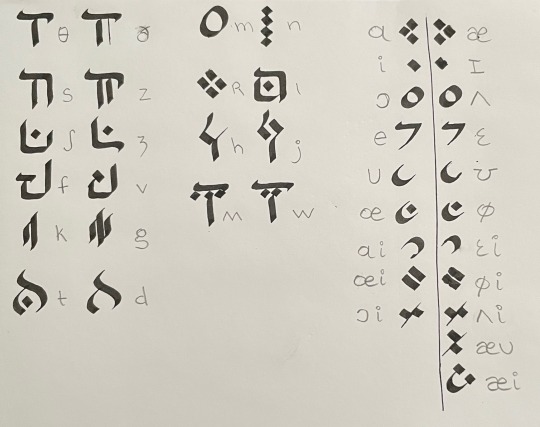
Derivation
I am working on more suffixes and prefixes to derive more words. So far I have the prefix "her-" which makes an adjective into a verb.
For example:
Gjalt - large, big
Hergjale - to enlarge, to grow
A suffix I have added it "-ym-" which takes a verb and turns it into the product or result of the verb, similar to "-age" in English.
For example:
Kåre - to cook
Kårymæs - food
68 notes
·
View notes
Text
So...
If you have seen my post about making a Salmonid Conlang, (which I deleted the file for to start over. don't worry, I haven't abandoned it.) I confess that my ambitions went beyond that.
Succinctly, I want to construct a Salmonid conlang, an Octarian conlang, and finally, a Mixed Language of the two. also, I want to create an Inkling conlang because it felt criminal to leave them out.
Now here's where it confuses me. predictably the Octarian conlang and Salmonid conlang are spoken by their respective species. this I find plausible due to the cultural and geographic barriers involved between the two parties. But this also takes place in a head canon alternate universe of mine. one where the Octarians and Salmonids collaborated on a project together.
That project being the combining of their respective biology. inspired by a post by @5tell4r, the Octarians managed to do just that, bringing into existence what you would know as "Salmonlings".
Long story short. the Octarians kept these Salmonlings on a research outpost that bordered on Salmonid territory. it is here that they were educated in the ways of both peoples, including their languages. Thus, what I call the Octo-Salmon language came to be. Due to competent teaching from both parties, it is thus a mixed language that combines phonological, grammatical, syntactic, and other features of both languages.
I also have an idea for story about a team of Salmonlings leaving the outpost to be the first of their kind to visit Inkopolis and/or Splatsville. They would slip into their native tongue - the Octo-Salmon language - when they get excited. but that's a story for later.
Like I stated above. to create this Octo-Salmon language I need to:
Create a Salmonid language
Create an Octarian language
Combine the two.
despite my deleting of the former, I am well on my way to creating the first one. the second one is more of a challenge mentally. and the third step is sure to be interesting.
Wish me luck, and till next time... ;).
#MVTJournalist speaks#conlang idea#conlang update#conlanging#conlang#constructed language#splatoon#splatoon 2#splatoon 3#salmonid#octarian#octoling#salmonling#inkling#world building#worldbuilding#fanfic writing#fanfiction#story ideas#long post
18 notes
·
View notes
Text
Aegir: Verbal Paradigm Idea 1
The idea right now is that, in addition to encoding tense and aspect, which is non-future and future for the former and Inchoative and Terminative in the latter, which I am not sure of keeping for now, the verbs of Aegir conjugate for whether the action happened in water or not, known respectively as Aquatic and Terrestrial.
#conlan#constructed language#conlanging#language construction#language creation#conlang update#conlang idea#arknights#aegir arknights#arknights fanfiction#arknights au#arknights headcanon#arknights fanfic
1 note
·
View note
Text

Tentative family chart for goblin-ken languages 🤔 In this setup Old Orcish is a pidgin->creole created after the Velothi Exodus through contact between the newly transformed orcs and their new goblin cousins. The Riekling dialect is considered part of the western family of Goblin-derived languages, despite their population's location on Solstheim, because it grew out of the Western dialect spoken by Riekrs who originally traveled across Skyrim.
There's no in-game evidence of east/west splits for ogres I just thought it made more sense than everyone across an enormous continent speaking the exact same language despite not having any central education system or even political capital.
93 notes
·
View notes
Text

Conlang Corner 5.16.2024
just another little letter to my dash friends
#conlang corner#wobblydev#wobbly dev#conlang#conlanging#sorry for the lack of any updates#fuss#dungeon meshi
10 notes
·
View notes
Text
Introducing: The Linguist's Phonetic Gallifreyan


This is a modification of Brittany G.'s Doctor's Cot Gallifreyan, which reorganized the layout of the Consonants and Vowels tables, adjusted how punctuation works, and added two new mechanics for quality of life. Its full title is The Linguist's Phonetic Gallifreyan, but the shorthand, for lack of a better idea, is GalliPhon. Interested to know the details? Read on!
I started working in Doctor’s Cot a few months ago. It’s interesting, and a fun change of pace from Sherman’s Circular, but it has a few flaws that have really started to dig at me. Firstly, despite the system being made to represent any language, it still is clearly made with English in mind. Nearly all English consonantal sounds are contained in the top left corner of the consonant table. While it does not bother me all that much that the system is made with English as the primary use — I do primarily use Sherman’s Circular, after all — it leads to all the consonants looking samey, and the layout feeling otherwise purely random. In a similar vein, all the English consonants being clustered together led to a lot of indistinguishable consonant pairs. I have dealt with this by leaving lines unconnected on one side, or dots attached to their corresponding circle, but this feels cheap, as Brittany did specify that indistinguishable consonants should be separated into new circles, which I find tedious and aesthetically displeasing. Another problem with the layout is that א’s circle ends up being a pain to make every time I need to write a word that starts with a vowel. For these reasons, I decided to reorganize the charts to have a more logical layout. And, while I was at it, I modified the formulation of punctuation to accommodate more punctuation marks and added two new mechanics to make formulating words less tedious: diphthong bridges and the reversal dot. As a warning, this is NOT a guide to the use of Phonetic Gallifreyan. To learn how to play, I would recommend checking out Brittany’s walkthrough, using my charts instead of the Doctor’s Cot ones.
The Consonant and Vowel Charts
They are now loosely organized based on the IPA categorizations in the 2020 chart. Broadly speaking: a single thin line corresponds to trills, taps, and approximants; double thin lines corresponds to laterals; a thin outer line and thick inner line corresponds to unvoiced fricatives; a thick outer line and thin inner line corresponds to voiced fricatives; double thick lines corresponds to nasals; and a single thick line corresponds to plosives. And for decorations (going from left to right in the chart because they are hard to describe): alveolar, retroflex, postalveolar, dental, “other symbols,” pharyngeal and glottal; labiodental; bilabial; uvular; velar; and palatal. The symbols do not always correspond exactly, but that’s the general organization I worked off of. For the vowels, I went easier on myself and organized them mostly by the English vowels, left-to-right O, U, A, I, and E. Additionally, as there are 28 base IPA vowel sounds but 30 spaces, I included the two most common diphthongs, ai and au. However, as I now have an option to make diphthongs, these are not recommended for use.
Diphthongs
I have added a function that will allow you to have two vowel sounds in a single circle, but only if they are part of a diphthong. Distinct vowel sounds must be in different syllable circles, even if there is no consonant between them. Two vowels in a dipthong, however, may be connected by a diphthong bridge, a line leading from the edge of the first vowel to the middle of the second. An example of both a diphthong and a still separate vowel can be seen in Ohio: /oˈhaɪ o/
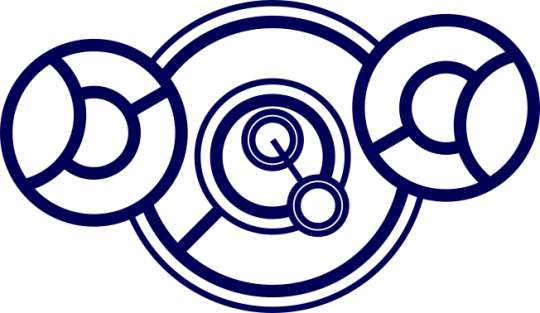
Vowel/Consonant Reversal
The other function I am adding is the reversal dot, necessitated by how annoying it is that words like “is,” “and,” and “or,” require two circles despite their simplicity. So, in Phonetic Gallifreyan, you can add a filled dot to the center of a word circle to indicate it should be read vowel first. Consonants still go outer circle first, then inner circle. As an example: “and” /ænd/

Punctuation
The primary change is that they don’t consist of two circles, just one. This way, a limited pool of punctuation can be combined to create more punctuation, like combining a period and a comma to make a semicolon, or three periods to make an ellipsis, or even some rarer punctuation like the interrobang (‽)

Credit to Brittany G. for the basis, and to Wikipedia and Phoible for research on IPA, punctuation, and more.
#UPDATED MARCH 27 2023#if you are translating any GalliPhon posted before this date you will get ɤ where ʊ was intended#the ʊ ɯ and ɤ vowels have been moved (essentially clockwise)#(mainly bc I was getting annoyed at how much space the oʊ dipthong took up)#also apologies for how terrible this all looks#unlike Brittany I am far from being a graphic designer#GalliPhon#gallifreyan#doctor who#The Linguist#conlang
165 notes
·
View notes
Text
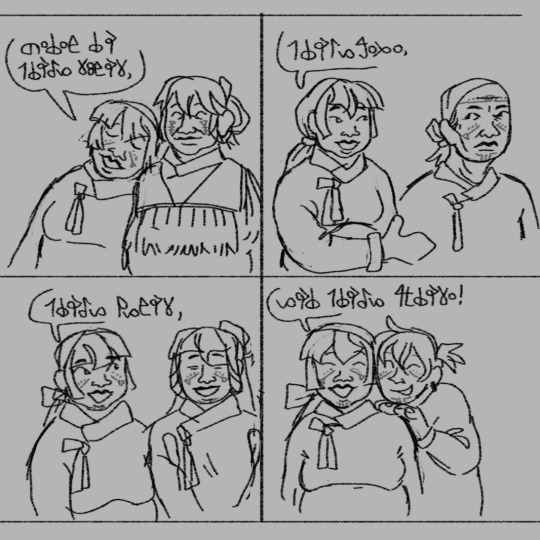

more conlang stuff (familial terms!) with palim and her family

plus a full kinship chart ⬆️
#oc: palim#oc: talm#oc: voh#worldbuilding project#conlang#phone art#comic#i updated the script again!!!!!!! because i am never satisfied woth anything ever!!!!
24 notes
·
View notes
Text
fyodor: our language will be free of imperfections and irregularities that plague common tongues. each sentence will follow a strict pattern that will describe the relations between subjects and objects, so that each thought and emotion can be spoken uniquely while always being understood and--what are you doing
dazai: 200 verb tenses. 300 noun cases. and they can permutate with each other and themselves to make millions of combinations. the verb is always split into two parts. the language has no words, only adjectives, pronouns, and relations. any word can be a swear word. any word can represent god. fuck you
fyodor: im going to enjoy killing you.
#conlang progress update#also my excuse for why its like this#its halfway between the most elegant thing youve ever seen and the most nightmarishly untranslatable language ever made#fyozai#synchrony
9 notes
·
View notes
Text
I want to make a list of everything that needs to agree with something in the time travel conlang, just to get my thoughts organized.
The guiding principle here is: Everything that might have cause to agree with something, does so. A Watsonian explanation for this would probably be something like, "there are a lot of ways time distortion could drop information or cause someone to miss it, and they would really like to know whether they're talking about their friend or an evil future version of their friend." The Doylist explanation is absolutely that I think it would be funny and fun and also I've never done any sort of agreement in a conlang before and have a lot to make up for.
The numbers this conlang inflects for are:
—Singular (needs no explanation)
—Monogender plural (a given group of one gender)
—Multigender plural (a given group of multiple genders)
—General plural (used for blanket statements that may or may not have exceptions, such as "stars give off heat" or "cats have fur")
The grammatical genders of this conlang are:
—Null (always and exclusively used for 1st, 2nd, 3rd, and 4th person)
—Former (past variant of myself, you, or a familiar 3rd person entity)
—Future (future variant as above)
—Alternate (alternate-timeline variant with a branch point in the past)
—Split (alternate-timeline version of a future variant, with a branch point in the future)
—Dopple (they're not a past or future version, our lives are identical, but somehow we exist separately at the same time and I need to gender them somehow)
(The distinction between 3rd and 3.5th person can get complicated. If I'm friends with someone named, say, Alice, and her future self travels back in time to now, then regardless of whom I'm speaking to, Alice is referred to in 3rd person and future-alice as Future 3.5th. If, however... let's say Nikola Tesla. If Tesla were to time-travel to 2023, and I met him, I would refer to him in 3rd person, because he would be the only Tesla I am familiar with and the only Tesla in this time frame.
On the other hand, if my grandfather were to travel through time as a young adult, and we met in the present, I would refer to him in 3.5th person, because I already know my grandfather as someone else. However, if I did the time-travelling, and met my grandfather in the past, I'd refer to him in 3rd person, and the version of him who is my grandfather in 3.5th... unless I happened to bring my present grandfather with me, in which case my present grandfather would be referred to in 3rd person and the past version in 3.5th.
Get it? By default, the native version of a person in the current time frame is referred to in 3rd person and all interlopers in 3.5th... unless they do not exist in that time frame, in which case the one with the greatest familiarity to the speaker is referred to in 3rd and all others in 3.5th, or if the speaker is travelling with the native version of that person to their time frame (or another person native to the same time frame who also knows the person), in which their native version is referred to in 3rd and all others in 3.5th.
As a sidenote: If my young grandfather (3.5th) time-travelled to a point after his death, but within my life, I would be well within my rights to refer to him in 3.5th person, even if he is the only version of himself in the current time. Those who did not know my grandfather at his current age, but met my time-travelling grandfather, would be well within their rights to refer to him in 3rd person and my present-day grandfather in 3.5th (future gender—or alternate, if my present-day grandfather didn't do any time travel in his own life).
(I don't know what you would do if Nikola Tesla showed up in 2023 in his time machine, then took you back in time to meet his self from a few years later in that self's native time. Leave it as exercise for the reader, I guess.)
—Adjectives agree with gender of the nouns they modify, by way of suffixes. If they need to agree with multiple genders, the suffixes are stacked in a set order. They're also inflected for number and for person, because you can expect to have an adjective attached to a 1.5th, 2.5th, 3rd, 3.5th, or 4th person noun/pronoun (e.g. in 1.5th person, "the evil me").
—Adverbs agree with the verbs they modify in terms of objective tense, again by way of a suffix.
—All persons of noun and pronoun that have multiple genders inflect for gender and number.
—Verbs are conjugated first for tense in objective time, then affixes are attached (these can be prefixes or suffixes) which encode person, gender (if applicable), and subjective tense for the subject and object. The positioning of these affixes is fluid, but they each point towards the nouns they're agreeing with.
—"No tense" is a valid objective tense for a verb whose objective tense is unknown, but whose subjective tense is known. For instance, if I know I'm going to mail you a letter, but I'm not sure when in time I'll be when I do so, I can refuse to inflect the verb for tense.
—A particle (which may act as an adjective or an adverb) can be constructed to indicate objective and/or subjective time for something not normally indicated. For instance, it might be attached to the noun "his texts" to indicate that the texts have not been written yet, or that whoever "he" is hasn't written them yet, but the texts themselves exist already, or to a verb to indicate that some third party (with which it agrees in number, gender, and person) has already experienced an event which is in the future for all other players in the sentence.
Verb objective tense conjugations tend to indicate the subject's person in some way. Some objective tenses lump 1st person with 1.5th person and so on, and others distinguish between them. I haven't decided yet, but this may be dependent on the base form of the verb. Like French! But worse.
#conlang#time travel conlang#<- also to swap out once it has a name#I think I'll be making this a dedicated project so uhh expect updates maybe?#vaguely coherent rambling#I don't know if I'm confident in my conlanging skills enough to declare that a feature in a language I'm making will be#“like French but even worse”#but hey#if any conlang I can make can be “like French but worse” this would be it#maybe I should see if I can dig up my notes from when I took it in high school#just for inspiration#I feel like looking at all the conjugations might be... helpful
11 notes
·
View notes
Text
OUR VOWELS HAVE BEEN FINALIZED!!!
Hey guys! Awesome news. Our vowels have been finalized according to the votes.
Our 10 vowels are i ɯ, e ø o, œ ʌ ɜ, a ɑ
Although "ɨ" was tied with "ɯ" on one of the polls, I also saw some feedback about not having enough variety in regards to the back vowels, so "ɯ" was chosen with this in mind.

Next is doing the same thing with the consonants.
12 notes
·
View notes
Text
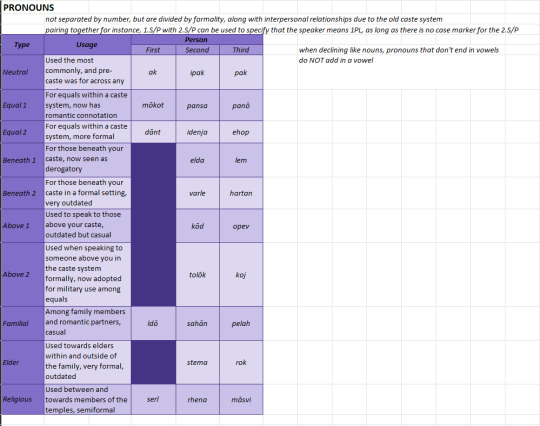
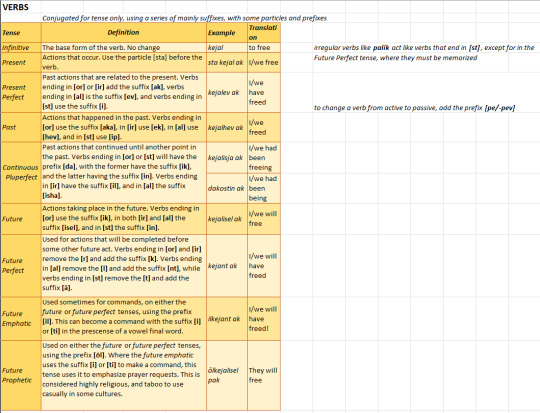
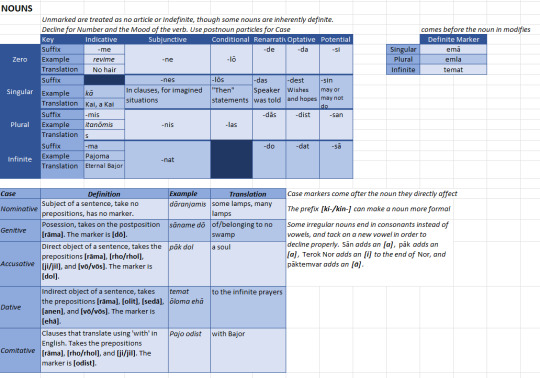
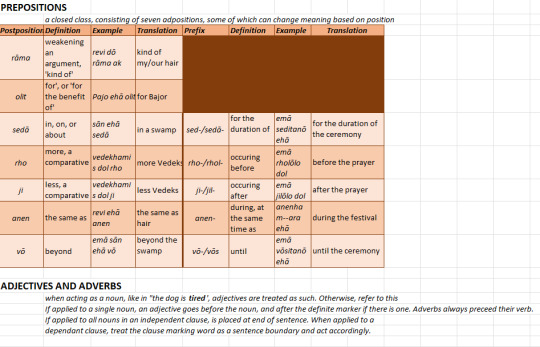
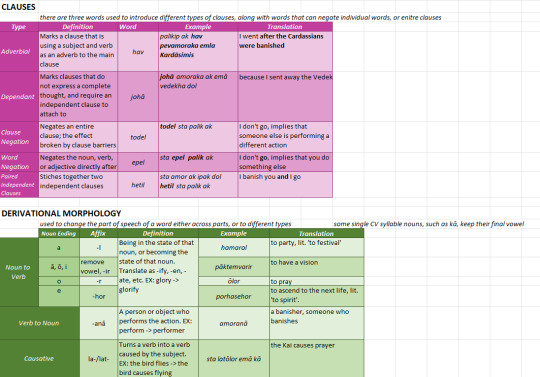
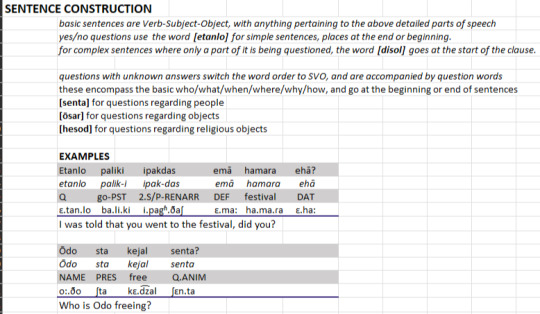
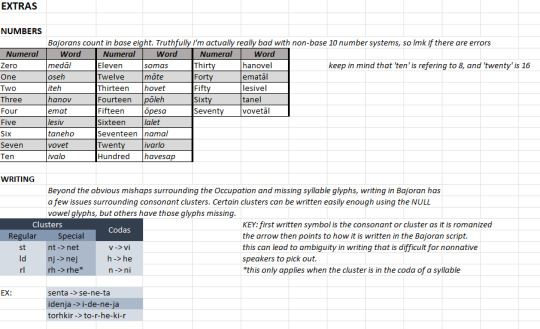
WOOHOO
full behind the scenes write up for Bajoran grammar, along with some extras regarding counting and writing
while not as... visually appealing as the writing system, a big part of conlanging for me is making sure the grammar is complete, even if potential users of the lang are just translating single words or short phrases. stuff relating to the pronouns is inspired by a few chapters of Lost in Translation(Patching the UT) by sayler_antimony over on AO3, with a majority of the rest of the vocab pulled from existing words in DS9 canon.
I'll prolly edit this post with a view-only link to a google sheets version of this with the dictionary attached just for ease of use, so be on the look out for that too!
edit: heres the spreadsheet link!
#that there art#ds9#star trek#bajoran#conlang#WHEW this took like all day#i say that knowing i got up at like noon#regardless#this plus my ever updating vocab list can be used by anyone for their Trek fics#i just ask that you please Please credit me as i've been workin real hard on this#hearts and kisses to you all btw
19 notes
·
View notes
Text
Conlang Progress Update - 5
Haven’t been up to much today because I have a lot of homework to do and do other boring adult things :((( but I have been messing around with the script and trying to hone it!
The Script
This is just some incoherent words put together. I’m getting a feel for the script. It almost looks like words form a key shape. I’m digging it!!!

63 notes
·
View notes
Text
Mass Effect Conlang Project
Am I a conlanger or am I a masochist? lol. either way, I have been compelled to at least create a list in my computers file system of races from the Mass Effect Franchise that I want to try constructing languages for.
I have sixteen species listed so far that I have created a word document dedicated to each one's grammar. those species being:
Angara
Asari
Batarian
Drell
Elcor
Hanar
Kett
Krogan
Leviathan
Prothean
Quarian
Salarian
Turian
Volus
Vorcha
Yahg
I will level with you who are reading this post. not all grammars are going to get the same amount of attention. some I will be more interested in and thus spend more time on (*cough cough* Krogan). Some will get a barebones description of their grammar (Currently unknown). Not only that, but I won't be sticking to the canon. I am going the path of the Without Hesitation fanfiction and making this a self-indulgent side project that I will be sharing with you.
but overall, I hope to have fun with this side project. and I hope you who are reading this will be amused by what I come up with.
#MVTJournalist speaks#conlang idea#conlang update#conlanging#fan conlang#fanficton#Mass effect#mass effect 2#mass effect 3#mass effect trilogy#mass effect andromeda#angara#mass effect angara#Asari#mass effect asari#batarian#mass effect batarian#drell#mass effect drell#elcor#mass effect elcor#hanar#mass effect hanar#kett#mass effect kett#krogan#mass effect krogan#leviathan#mass effect leviathan#prothean
10 notes
·
View notes
Text
Wish I had some art to share.
But!
I do have tons of updates.
FIRST Dreamy Oak is still in progress!
It's clearly going to be a big game and will require a lot of fiddling before I begin playtesting in pieces. I'm looking for similar systems to what I'm doing and coming up null. While I enjoy being 'original' I'm also a natural skeptic. That being said...
If you have heard of a game using blackjack as a conflict resolution and poker as an oracle and the two work in tandem, I'd appreciate some examples.
In the meantime I need A LOT OF oracles, to settle for the main game loop, further character creation, create character abilities, spit shine the world-building, and feed it my artwork for that ol' ✨razzle-dazzle✨. And that's what I can think of dome.
Second, I am working on a Honey Heist hack called Let Sleeping Dogs Lie.
Let Sleeping Dogs Kid is about trying to best your rival by adding finishing touches to a completed project the night before it's due when you're already dog-tired. You will make mistakes, but you will also have strokes of genius! Will you chug Red Bulls into a caffeine-induced craze but with dry results? Or will you give into the lullaby of sleep's sweet embrace and only dream of the majesty you could have done?
This one is a matter of finishing the oracles, tweaking the oracles, and adding my own hand-drawn art and the masses can have at it.
And as if I am not a psycho on a mission already I'm working on a comic.
It is about Hiero Glyph Inkwell, a daemon and apprentice Book Master. They were cursed to lose their ability to read, write, and speak in all living languages. Now, they are constructing a new language from the remaining sounds within their name to remove a curse and save communication everywhere!
What do I need there? Aha... To learn linguistics and conlanging and how to tell a compelling story with consistent artwork. Nothing too big. Aha..
So you know. I'm busy.
#ttrpg#writing#indie rpgs#ttrpg design#linguistics#Dream Oak#comics#update#conlang#indie ttrpg#original comic#indie comics#honey heist
6 notes
·
View notes
Text
I am currently hard at work on a new list of the Sul'voth runes to have as a permanent resource here, with a cleaner and more accessible aesthetic, as well as a few adjustments.
This set will be the final iteration, which will also allow me to focus on the next steps, namely the actual Lexicon and the upcoming Patreon page. Not to mention my return to creating videos, so stay tuned.
Cheers folks, and good tidings.
18 notes
·
View notes
Text
New Domain, Same App
Due to unforeseen circumstances, Lexiconga's domain name has been changed to https://lexiconga.com. While I prefer the old lexicon.ga address, I don't believe I'm going to be able to reclaim the domain for a while as control of the .ga registrar is being settled (though I'll definitely be on the lookout for it!).
The Lexiconga app remains exactly the same, and you can use your same login credentials to access your same dictionaries if you created an account.
Recovering Local-Only Dictionaries
If you did not create an account and your dictionary is only saved locally, there may still be a way to get your dictionary and import it back into lexiconga.com! Unfortunately, this will only work if you have been using Lexiconga on a browser that can access its Developer Tools.
1. Visit https://lexicon.ga
The page will either look weird and say "You are OFFLINE" OR your browser will say something like "This site can’t be reached. lexicon.ga’s server IP address could not be found." This is fine.
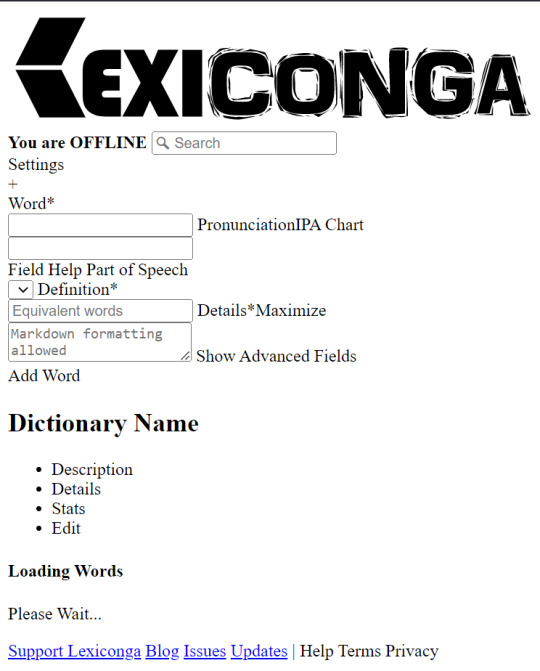
2. Right click the page and click "Inspect" from the menu
This will bring up the Developer Tools in most browsers that use Chromium or Firefox.

3. Click the "Application" tab and find "Local Storage" in the sidebar
At the top of the developer tools are tabs. Sometimes "Application" can be hidden within a button double arrows.
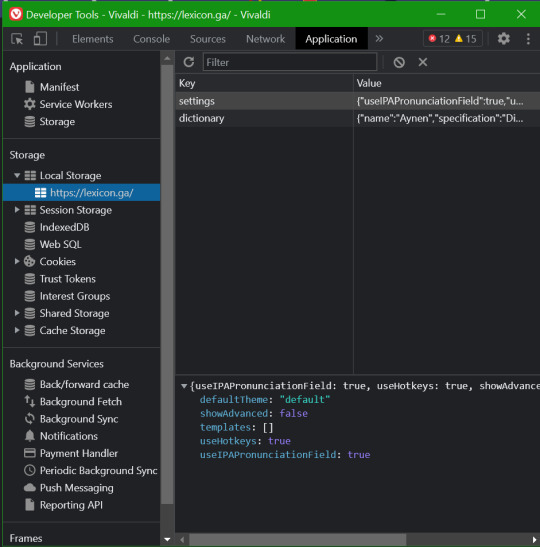
4. Copy & save the data
All your dictionary data and settings are stored in local storage. Make note of the key names and copy the JSON data into a text file.
5. Paste the data into lexiconga.com
Repeat steps 2 and 3 on the new domain, and when you see the empty local storage data, double-click in the key area and type the key of the data (either "settings" or "dictionary"), then in the value area, paste the data you copied eariler.
6. Refresh the page and continue as normal
If you did it correctly, your old dictionary should appear immediately as if nothing ever happened!
Please let me know if you run into any issues with this process, but if you copy and paste precisely, it shouldn't be any trouble.
#update#Lexiconga#conlanging#constructed languages#conlangs#tool#web development#webdev#internet#helpful#guide
7 notes
·
View notes